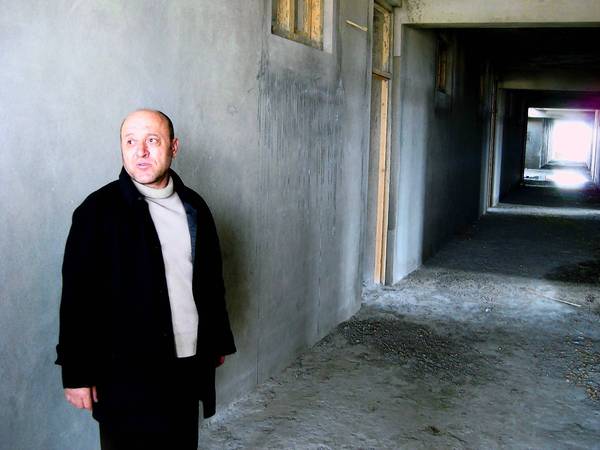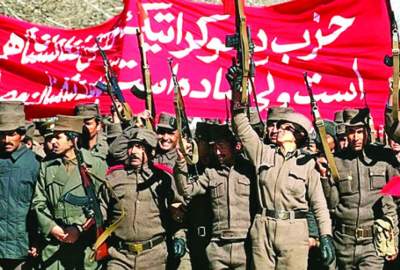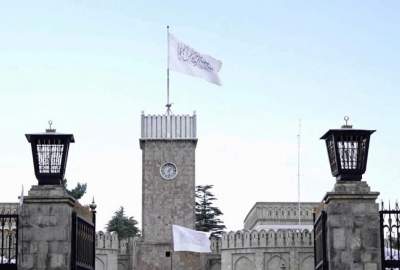As an 11-year effort winds down, U.S. provincial reconstruction teams, or PRTs, have made gains but have also left infrastructure that is incomplete, unsustainable or incompatible with local needs.
At the doorstep of the U.S.-funded schoolhouse in this mountain-fringed northern town, Ghulam Nabi crouched in the mud and scooped up two rocks. He needed them, the school engineer explained, to scare off the building's only regular occupant: a stray dog.
Nearly four years after ground was broken, the 24-room $310,000 high school stands unfinished, a bleak monument to America's unrealized ambitions in Afghanistan. Graffiti scars the entrance. Water stains blot the ceiling. Unconnected electrical wires reach out from the walls like aimless tentacles.
The concrete shell is one of at least six uncompleted schoolhouses in Parwan province that were financed by a U.S. provincial reconstruction team as part of a decade-long nation-building effort now winding down as the U.S. war in Afghanistan draws to a close.
The teams, known as PRTs, composed mainly of soldiers assisted by a few civilian development experts, have left a mixed legacy in places like Charikar, an hour's drive north of Kabul. Starting in 2002, U.S. teams poured hundreds of millions of dollars a year into new roads, bridges, health clinics and schoolhouses in an effort to win hearts and minds, bolster the Afghan government and improve security.
But in the headlong rush to achieve those goals, the 12 teams also saddled Afghanistan's impoverished provinces with infrastructure that wasn't completed, can't be sustained or didn't mesh with local needs.
The PRTs have been responsible for only a fraction of the $89 billion the United States has spent over the last decade to rebuild Afghanistan, but they suffered from the same poor planning and inadequate oversight that characterized the broader U.S. reconstruction effort. With four of the PRTs now shut down, and seven others due to be retired by summer's end, Afghan officials are beginning to confront the challenge of picking up where U.S. aspirations left off.
The schoolhouse in Charikar may never open because the PRT at the nearby Bagram air base has stopped working in the area, the Afghan builders say they've run out of money, and the provincial government lacks the funding to finish construction. For now, local education officials are dipping into their meager budget to pay a security guard to ward off squatters.
Another school in Parwan was so shoddily built by the U.S. team's Afghan contractors that a giant beam had to be erected to keep the roof from caving in, provincial officials said; five years later, they still won't allow students inside. In the mountain district of Surkh-e-Parsa, the U.S. financed a two-story, 24-room schoolhouse even though the surrounding villages didn't have anywhere near enough children to fill it.
"If you collected the whole area around it, they wouldn't even fill the first floor," Mohammed Azizyar, the lead engineer for the provincial education department, said one recent morning at his office in Charikar. Meanwhile, at a decades-old facility in a different district, 12 grade levels were crammed into five classrooms.
"If they would have coordinated with us, we would have given them a better idea of where we needed new buildings," Azizyar said. "That was our main problem with the PRT. They could start projects very quickly. But many times they didn't follow the policies and strategies of the education department."
Proponents say the teams established a U.S. military presence in far-flung provinces, built roads to connect remote villages and constructed public buildings at a pace perhaps unequaled in Afghanistan's history.
U.S. officials point to dramatic improvements in maternal health, infant mortality, school attendance and other indicators as evidence that the reconstruction effort in the provinces has succeeded.
"PRTs have provided much-needed assistance and support at a time when the Afghan government was not in a position to provide basic services in the provinces and districts," said Alexandra Taylor, a spokeswoman for the U.S.-led NATO coalition.
U.S. officials could not provide breakdowns of how much money the teams spent or how many projects they carried out. The bulk of PRT funding came from the Pentagon's $3.45-billion Commander's Emergency Response Program, intended for small quick-impact projects, with the State Department, Army Corps of Engineers, Agency for International Development and others kicking in additional money.
Since the Sept. 11 attacks that preceded the invasion of Afghanistan, the U.S. military increasingly has viewed relief and reconstruction as crucial to fighting terrorism in failing states. The Pentagon established PRTs in Afghanistan and Iraq, assigning troops to development work usually reserved for civilian agencies.
A decade later, there remains considerable debate within the U.S. government over the merits of that strategy. A 2011 report by the Senate Committee on Foreign Relations found "limited" evidence that aid could buy stability in Afghanistan and said that "the unintended consequences of pumping large amounts of money into a war zone cannot be underestimated."
Many critics say the teams squandered money on projects that fit short-term military objectives but had questionable long-term value.
"A lot of it will endure, but a lot of it was wasted," said Gerald Meyerle, a senior research scientist at the nonprofit CNA research group who has advised the U.S. military in Afghanistan.
The teams were led by military commanders who, at least in the early years, were unprepared for the details of reconstruction work. Experts say that some projects fueled instability by favoring certain warlords or ethnic groups, while others were assigned to fly-by-night Afghan contractors who pocketed the cash without completing the work.
The troops typically deployed for less than a year, sometimes leaving behind projects that replacement units were unable or unwilling to finish. Commanders were judged on what they conceived and delivered and how much they spent, so new projects often took priority over old ones, officials and experts said.
(LaTime)
At the doorstep of the U.S.-funded schoolhouse in this mountain-fringed northern town, Ghulam Nabi crouched in the mud and scooped up two rocks. He needed them, the school engineer explained, to scare off the building's only regular occupant: a stray dog.
Nearly four years after ground was broken, the 24-room $310,000 high school stands unfinished, a bleak monument to America's unrealized ambitions in Afghanistan. Graffiti scars the entrance. Water stains blot the ceiling. Unconnected electrical wires reach out from the walls like aimless tentacles.
The concrete shell is one of at least six uncompleted schoolhouses in Parwan province that were financed by a U.S. provincial reconstruction team as part of a decade-long nation-building effort now winding down as the U.S. war in Afghanistan draws to a close.
The teams, known as PRTs, composed mainly of soldiers assisted by a few civilian development experts, have left a mixed legacy in places like Charikar, an hour's drive north of Kabul. Starting in 2002, U.S. teams poured hundreds of millions of dollars a year into new roads, bridges, health clinics and schoolhouses in an effort to win hearts and minds, bolster the Afghan government and improve security.
But in the headlong rush to achieve those goals, the 12 teams also saddled Afghanistan's impoverished provinces with infrastructure that wasn't completed, can't be sustained or didn't mesh with local needs.
The PRTs have been responsible for only a fraction of the $89 billion the United States has spent over the last decade to rebuild Afghanistan, but they suffered from the same poor planning and inadequate oversight that characterized the broader U.S. reconstruction effort. With four of the PRTs now shut down, and seven others due to be retired by summer's end, Afghan officials are beginning to confront the challenge of picking up where U.S. aspirations left off.
The schoolhouse in Charikar may never open because the PRT at the nearby Bagram air base has stopped working in the area, the Afghan builders say they've run out of money, and the provincial government lacks the funding to finish construction. For now, local education officials are dipping into their meager budget to pay a security guard to ward off squatters.
Another school in Parwan was so shoddily built by the U.S. team's Afghan contractors that a giant beam had to be erected to keep the roof from caving in, provincial officials said; five years later, they still won't allow students inside. In the mountain district of Surkh-e-Parsa, the U.S. financed a two-story, 24-room schoolhouse even though the surrounding villages didn't have anywhere near enough children to fill it.
"If you collected the whole area around it, they wouldn't even fill the first floor," Mohammed Azizyar, the lead engineer for the provincial education department, said one recent morning at his office in Charikar. Meanwhile, at a decades-old facility in a different district, 12 grade levels were crammed into five classrooms.
"If they would have coordinated with us, we would have given them a better idea of where we needed new buildings," Azizyar said. "That was our main problem with the PRT. They could start projects very quickly. But many times they didn't follow the policies and strategies of the education department."
Proponents say the teams established a U.S. military presence in far-flung provinces, built roads to connect remote villages and constructed public buildings at a pace perhaps unequaled in Afghanistan's history.
U.S. officials point to dramatic improvements in maternal health, infant mortality, school attendance and other indicators as evidence that the reconstruction effort in the provinces has succeeded.
"PRTs have provided much-needed assistance and support at a time when the Afghan government was not in a position to provide basic services in the provinces and districts," said Alexandra Taylor, a spokeswoman for the U.S.-led NATO coalition.
U.S. officials could not provide breakdowns of how much money the teams spent or how many projects they carried out. The bulk of PRT funding came from the Pentagon's $3.45-billion Commander's Emergency Response Program, intended for small quick-impact projects, with the State Department, Army Corps of Engineers, Agency for International Development and others kicking in additional money.
Since the Sept. 11 attacks that preceded the invasion of Afghanistan, the U.S. military increasingly has viewed relief and reconstruction as crucial to fighting terrorism in failing states. The Pentagon established PRTs in Afghanistan and Iraq, assigning troops to development work usually reserved for civilian agencies.
A decade later, there remains considerable debate within the U.S. government over the merits of that strategy. A 2011 report by the Senate Committee on Foreign Relations found "limited" evidence that aid could buy stability in Afghanistan and said that "the unintended consequences of pumping large amounts of money into a war zone cannot be underestimated."
Many critics say the teams squandered money on projects that fit short-term military objectives but had questionable long-term value.
"A lot of it will endure, but a lot of it was wasted," said Gerald Meyerle, a senior research scientist at the nonprofit CNA research group who has advised the U.S. military in Afghanistan.
The teams were led by military commanders who, at least in the early years, were unprepared for the details of reconstruction work. Experts say that some projects fueled instability by favoring certain warlords or ethnic groups, while others were assigned to fly-by-night Afghan contractors who pocketed the cash without completing the work.
The troops typically deployed for less than a year, sometimes leaving behind projects that replacement units were unable or unwilling to finish. Commanders were judged on what they conceived and delivered and how much they spent, so new projects often took priority over old ones, officials and experts said.
(LaTime)
Source : AfghanVoice Agency(AVA), International Service







